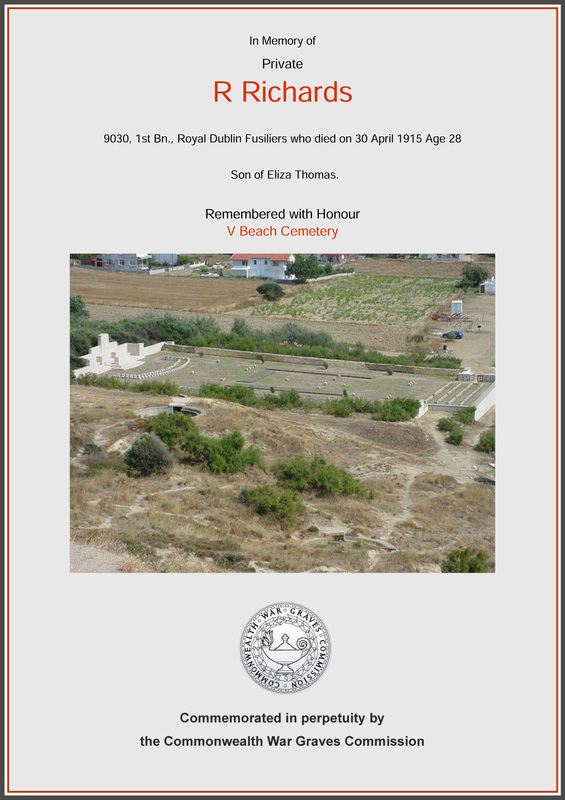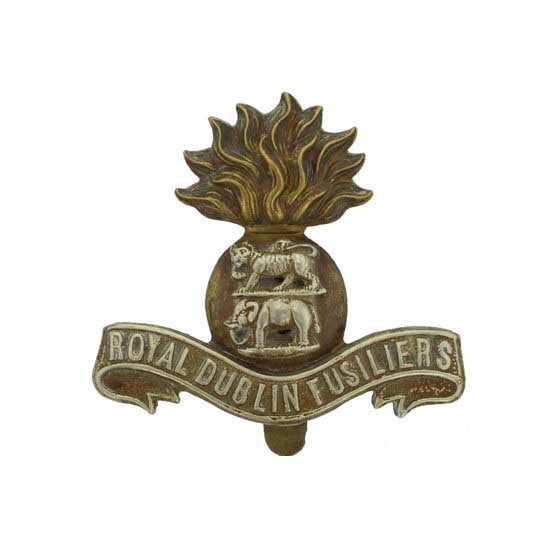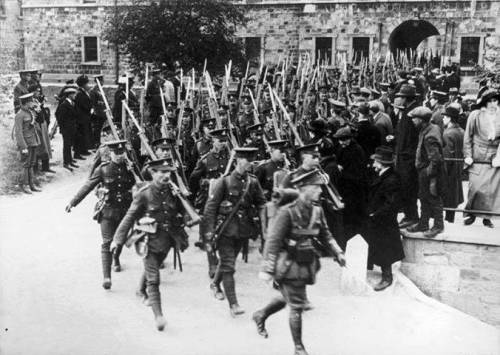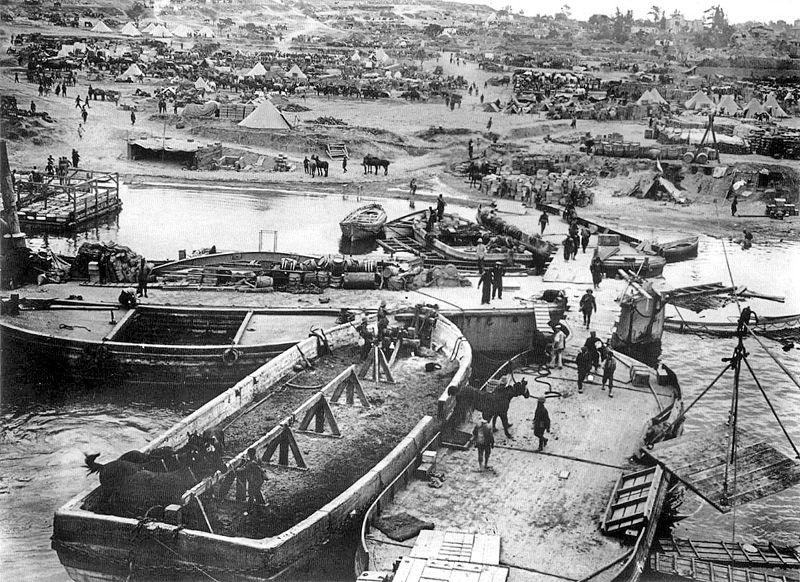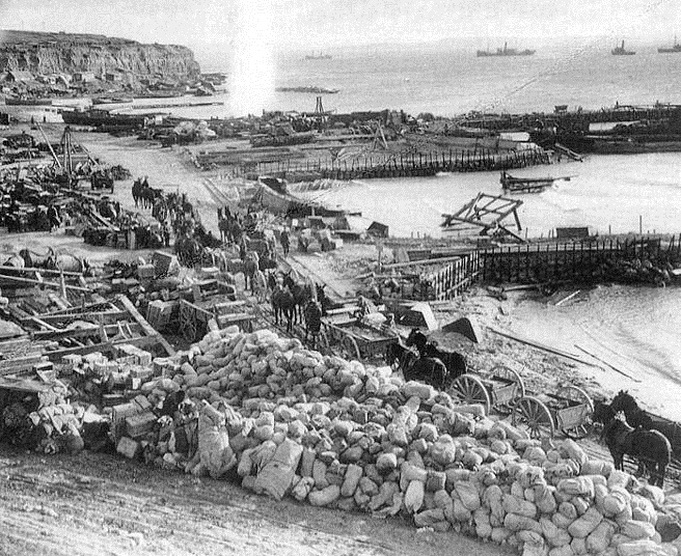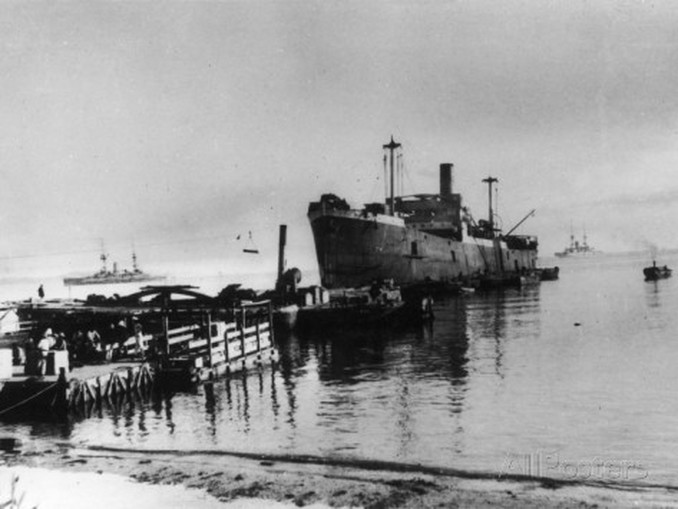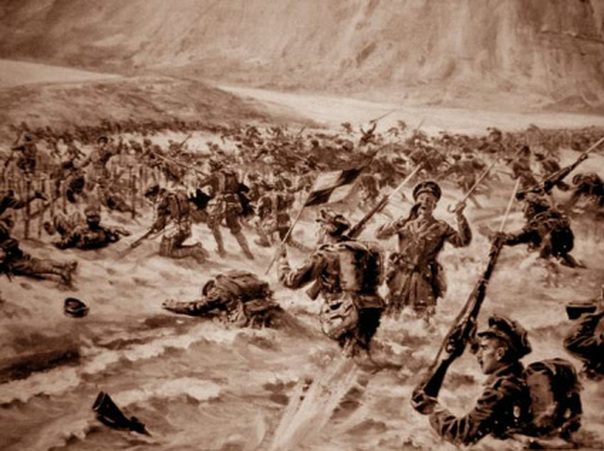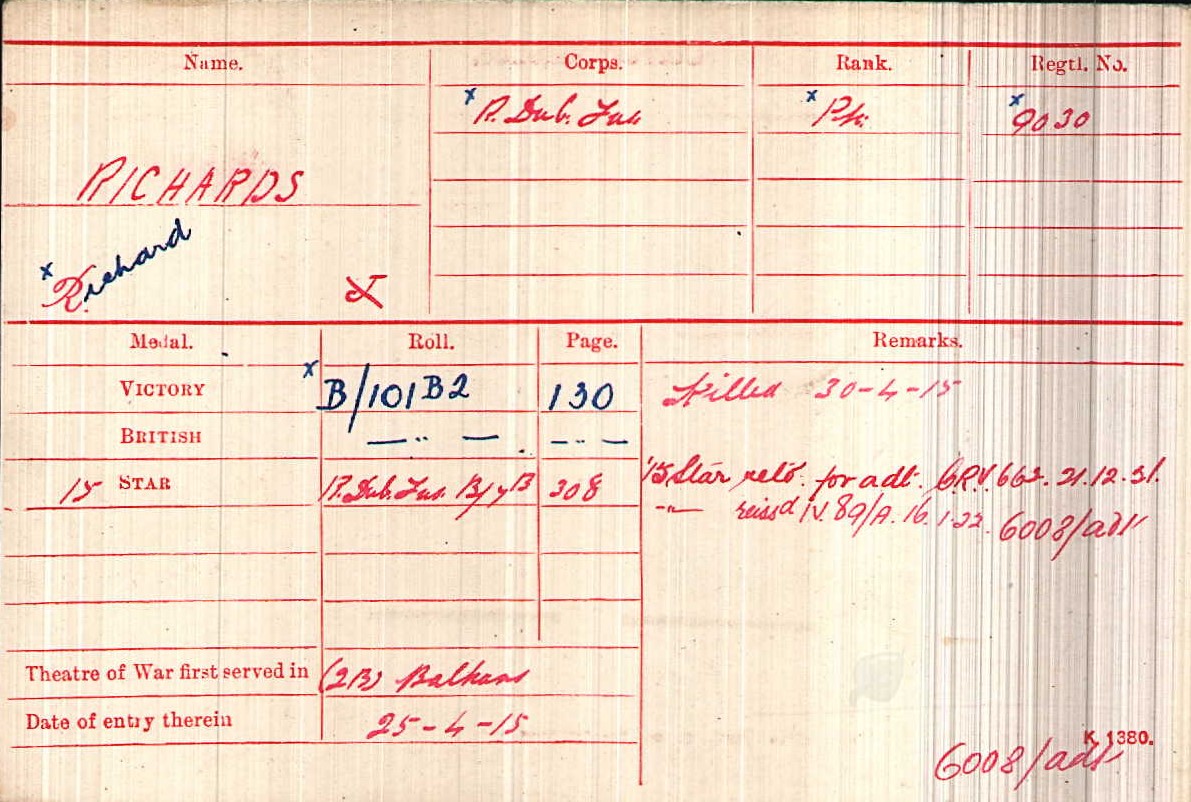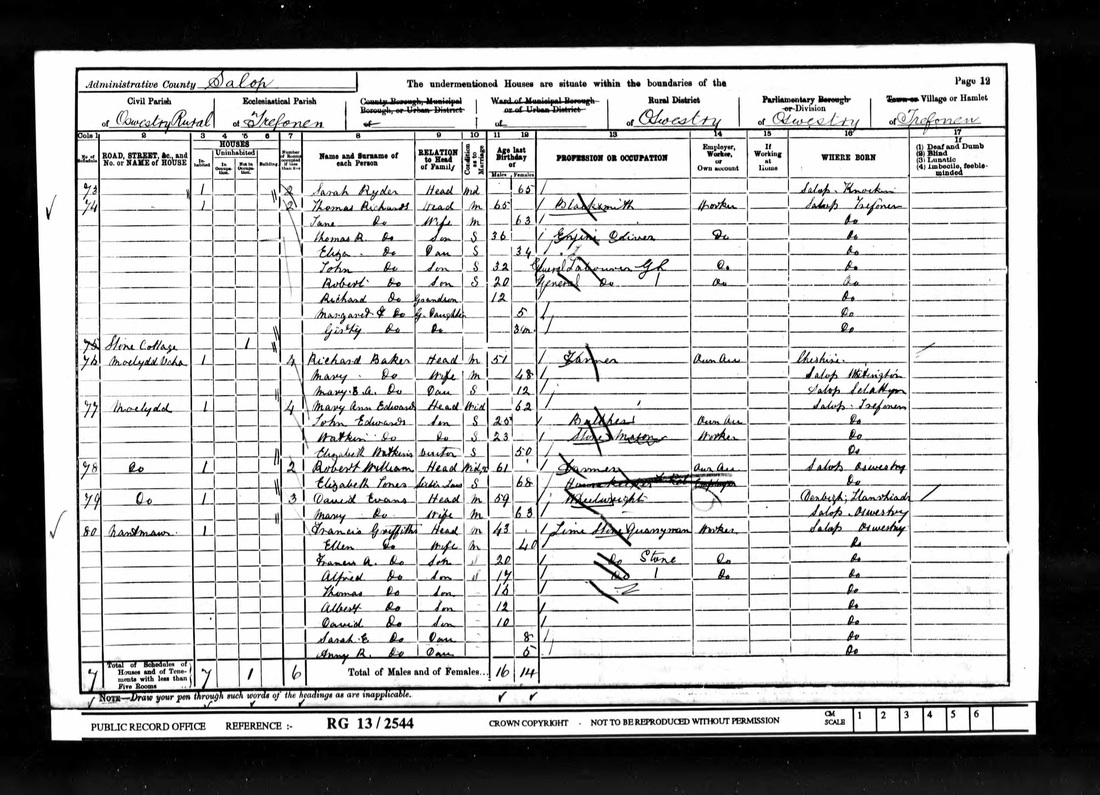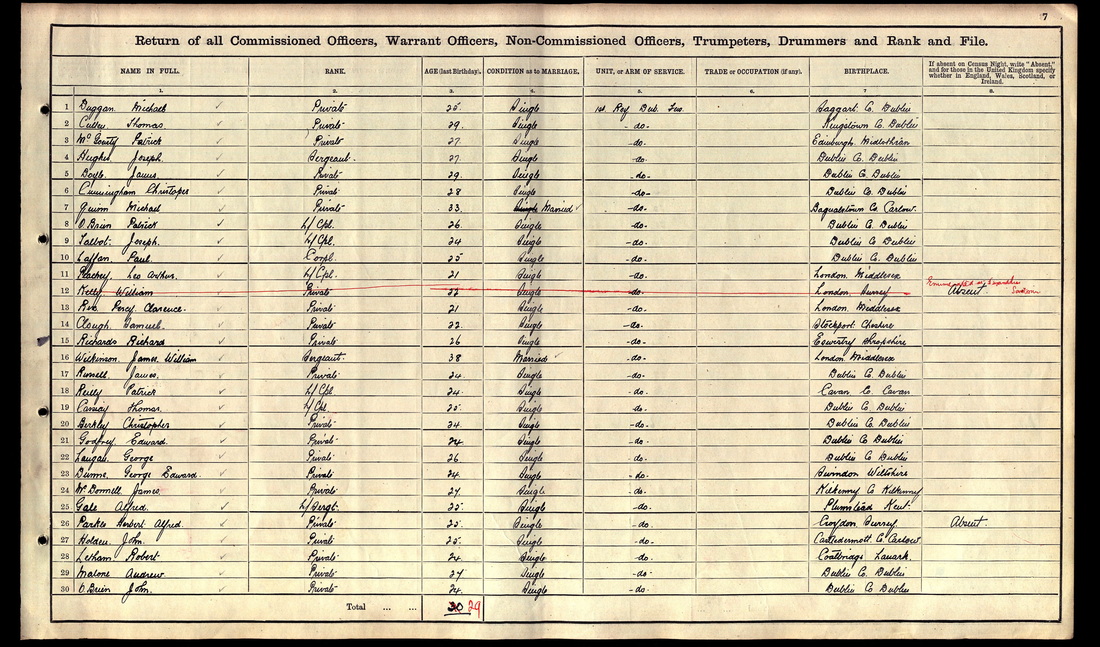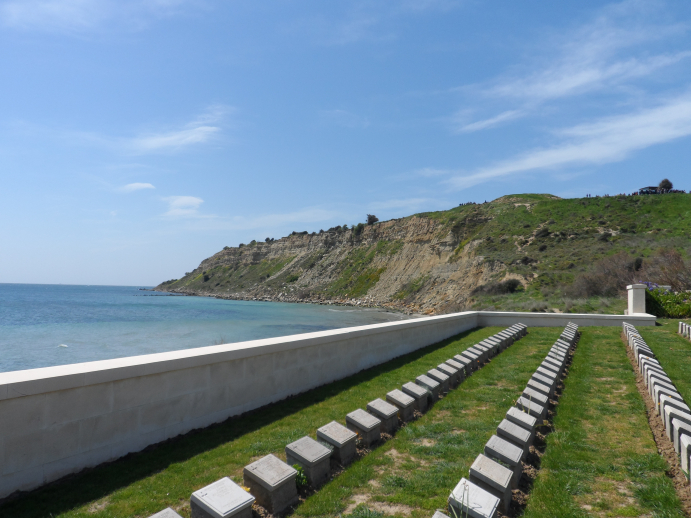Richard Richards
|
Introduction
Richard Richards was born in 1889 and lived with his Mother and Grandparents initially at Three Trees Cottage, Trefonen (1901 census) He was still living with them in 1901 but in 1905 aged just 16 he enlisted in Litchfield with the Royal Dublin Fusiliers. Why he chose to do this and what if any connection he had with the Irish we are unsure, it may simply have been by joining up he hoped to see the world. |
|
Military Record including Regimental and Battalion information
Private Richard Richards enlisted in 1905 aged just 16. He joined the Royal Dublin Fusiliers and we know that prior to the First World War they were stationed for a considerable time in India. He was sadly to meet his end in perhaps one of the most well known massacres of the First World War. (see below) |
Gallipoli - The Helles Landings:
The Allied commanders believed that controlling the Dardanelles could have ended the war by forcing a negotiated settlement without the intervention of the United States. In attacking the Dardanelles the plan by the First Lord of the Admiralty, Winston Churchill, was to draw German troops from the Western Front to help Turkey. Success would further mean that British allies, the Russians, could use the Dardanelles for use by their Black Sea fleet. Churchill had Naval backing for the operation, but Kitchener, however, was not prepared to transfer soldiers from the Western Front. Kitchener’s new armies were still in training and the regular army was fully stretched in Flanders.
There was one Division of the regular army which had not been used, this was the 29th Division. It contained the 1st Battalion of the Royal Dublin, Munster and Inniskilling Fusiliers. At the outbreak of war in 1914, the 1st Battalion of the Dublin Fusiliers had been based at Madras in India. On the 19th of November 1914, they sailed from back from Bombay arriving at Plymouth on the 21st of December 1914.
The Allied commanders believed that controlling the Dardanelles could have ended the war by forcing a negotiated settlement without the intervention of the United States. In attacking the Dardanelles the plan by the First Lord of the Admiralty, Winston Churchill, was to draw German troops from the Western Front to help Turkey. Success would further mean that British allies, the Russians, could use the Dardanelles for use by their Black Sea fleet. Churchill had Naval backing for the operation, but Kitchener, however, was not prepared to transfer soldiers from the Western Front. Kitchener’s new armies were still in training and the regular army was fully stretched in Flanders.
There was one Division of the regular army which had not been used, this was the 29th Division. It contained the 1st Battalion of the Royal Dublin, Munster and Inniskilling Fusiliers. At the outbreak of war in 1914, the 1st Battalion of the Dublin Fusiliers had been based at Madras in India. On the 19th of November 1914, they sailed from back from Bombay arriving at Plymouth on the 21st of December 1914.
They were billeted at Torquay until St. Patrick’s Day 1915, when they left from Avonmouth and sailed for Gallipoli going via Alexamdria and Mudros, where their transport anchored on 9 April.
They were part of 86th Infantry Brigade under Brigadier-General S. W. Hare. On the 23rd April 1915, ship after ship steamed out of Mudros Harbour with an army made up of British, Colonial and French troops, sailing through the line of battleships and smaller warships, which cheered them on their way. The Royal Munster and the Royal Dublin Fusiliers in the S.S. River Clyde; the Brigade Headquarters were in the mine-sweeper S.S. Whitby Abbey.
The 29th Division had orders to land at the southern tip of the Dardanelles peninsula, at Cape Helles. It proved to be an extremely unsuitable landing place. The beaches were either open beaches without any cover, or else the land rose straight up from the sea, and in either case defensive positions with machine gun emplacements could desimate troops landing from the sea.. The British plan of attack was first a naval bombardment of the Turkish positions around the Village of Sedd-el-Bahr, followed by a landing of troops. The naval bombardment failed to destroy the Turkish defences before the troops landed.
The night before the attack on the 25th of April, none of the men could sleep on board the Clyde through fear and apprehension. Cocoa was issued all round. At 0500 hours, the navy began their bombardment of the Turkish positions around the village of Sedd-el-Bahr. Before the Dublins and Munsters approached the beaches, their Brigade Commander addressed his men saying, ‘Fusiliers, our brigade has the honour of the first to land.’
They were part of 86th Infantry Brigade under Brigadier-General S. W. Hare. On the 23rd April 1915, ship after ship steamed out of Mudros Harbour with an army made up of British, Colonial and French troops, sailing through the line of battleships and smaller warships, which cheered them on their way. The Royal Munster and the Royal Dublin Fusiliers in the S.S. River Clyde; the Brigade Headquarters were in the mine-sweeper S.S. Whitby Abbey.
The 29th Division had orders to land at the southern tip of the Dardanelles peninsula, at Cape Helles. It proved to be an extremely unsuitable landing place. The beaches were either open beaches without any cover, or else the land rose straight up from the sea, and in either case defensive positions with machine gun emplacements could desimate troops landing from the sea.. The British plan of attack was first a naval bombardment of the Turkish positions around the Village of Sedd-el-Bahr, followed by a landing of troops. The naval bombardment failed to destroy the Turkish defences before the troops landed.
The night before the attack on the 25th of April, none of the men could sleep on board the Clyde through fear and apprehension. Cocoa was issued all round. At 0500 hours, the navy began their bombardment of the Turkish positions around the village of Sedd-el-Bahr. Before the Dublins and Munsters approached the beaches, their Brigade Commander addressed his men saying, ‘Fusiliers, our brigade has the honour of the first to land.’
25 April 1915
At 06.25, the naval bombardment stopped and the skipper of the Clyde, Commander Unwin, ran her aground on the beach just under the ancient Fort at Sedd-el-Bahr. The section of the beach assigned to the Dublin and Munster Fusiliers was called 'V' Beach.
Sides had been cut out of the Clyde and the landing plan was for the Clyde to be beached and that the 2000 men inside her would run down wooden gangways onto pontoons that had been dragged near the shore alongside the ship. From the pontoons the men would jump onto the beach and advance inland to fight the Turks. Machine gun fire would cover the men coming ashore. But it all went wrong. The German commander advising with the Turks, General Von Sanders, knew that Cape Helles was a vitally important part of the peninsula to defend so he had heavily defended it with barbed wire under the water, and along the ridge he placed more wire and machine-gun placements.
The Dubliners, Munsters and Hampshires did not stand a chance. Further round the Cape Helles headland, Australians and New Zealand forces tried to land as well. They too were held back by brave Turks. Here are some other eye-witness accounts.
"About this time three companies of Royal Dublin Fusiliers and one platoon of Anson Battallion RND embarked from mine sweepers into six tows of boats, each made up of a pinnace and four cutters. They were intended to land half an hour in advance of the men from the River Clyde. Five tows onto V beach and 1 tow to Camber, a small harbour to the right of V beach. Captain Guy Nightingale who was on the Clyde wrote in a letter dated 1 May 1915 - the water was shallower than they thought and the Clyde was stuck about 80 yards out ... None of us felt it, there was no jar. As she beached 2 Companies of the Dublins in "Tows" came up on the Port side and were met with a terrific rifle and machine gun fire. They were literally slaughtered like rats in a trap. Many men sank owing to the weight of their equipment and were drowned. The carnage on 'V' Beach was chilling, dead and wounded lay at the waters edge tinted crimson from their blood......... After being set adrift by their steam pinnaces, the boats had to row the last few hundred yards to the shore. The Turks waited until the men tossed their oars and were within 20 yards of the shore and swept them with fire.......... Lt Col Tizzard said - I donï think that out of the 240 men in the boats more than 40 got ashore without being hit. Most were killed outright, many sank from exhaustion and loss of blood and were drowned, the water by this time was red with blood ........ As each boat got near the shore snipers shot down the oarsmen. The boats then began to drift, and machine gun fire was turned onto them, you could see the men dropping everywhere, and of the first boat load of 40 men only 3 reached the shore, all wounded. In his diary entry for 25 April 1915 he says the Dublins lost 21 Officers and 560 men in 15 minutes"
At 06.25, the naval bombardment stopped and the skipper of the Clyde, Commander Unwin, ran her aground on the beach just under the ancient Fort at Sedd-el-Bahr. The section of the beach assigned to the Dublin and Munster Fusiliers was called 'V' Beach.
Sides had been cut out of the Clyde and the landing plan was for the Clyde to be beached and that the 2000 men inside her would run down wooden gangways onto pontoons that had been dragged near the shore alongside the ship. From the pontoons the men would jump onto the beach and advance inland to fight the Turks. Machine gun fire would cover the men coming ashore. But it all went wrong. The German commander advising with the Turks, General Von Sanders, knew that Cape Helles was a vitally important part of the peninsula to defend so he had heavily defended it with barbed wire under the water, and along the ridge he placed more wire and machine-gun placements.
The Dubliners, Munsters and Hampshires did not stand a chance. Further round the Cape Helles headland, Australians and New Zealand forces tried to land as well. They too were held back by brave Turks. Here are some other eye-witness accounts.
"About this time three companies of Royal Dublin Fusiliers and one platoon of Anson Battallion RND embarked from mine sweepers into six tows of boats, each made up of a pinnace and four cutters. They were intended to land half an hour in advance of the men from the River Clyde. Five tows onto V beach and 1 tow to Camber, a small harbour to the right of V beach. Captain Guy Nightingale who was on the Clyde wrote in a letter dated 1 May 1915 - the water was shallower than they thought and the Clyde was stuck about 80 yards out ... None of us felt it, there was no jar. As she beached 2 Companies of the Dublins in "Tows" came up on the Port side and were met with a terrific rifle and machine gun fire. They were literally slaughtered like rats in a trap. Many men sank owing to the weight of their equipment and were drowned. The carnage on 'V' Beach was chilling, dead and wounded lay at the waters edge tinted crimson from their blood......... After being set adrift by their steam pinnaces, the boats had to row the last few hundred yards to the shore. The Turks waited until the men tossed their oars and were within 20 yards of the shore and swept them with fire.......... Lt Col Tizzard said - I donï think that out of the 240 men in the boats more than 40 got ashore without being hit. Most were killed outright, many sank from exhaustion and loss of blood and were drowned, the water by this time was red with blood ........ As each boat got near the shore snipers shot down the oarsmen. The boats then began to drift, and machine gun fire was turned onto them, you could see the men dropping everywhere, and of the first boat load of 40 men only 3 reached the shore, all wounded. In his diary entry for 25 April 1915 he says the Dublins lost 21 Officers and 560 men in 15 minutes"
The Brigade Staff landed on beach "W." They saw that no troops appeared to have moved on to the high ground. The Brigade-Major and Staff-Captain, returned to the beach with the idea of getting troops forward on to Hill 138 and Hill 141, to take the Turkish redoubts thereon, and to assist the advance of the Royal Munster and Royal Dublin Fusiliers from "V" Beach, also to establish Brigade Headquarters at the ruined light-house, which had previously been named as a spot to which all reports should be sent when a footing had been secured. This lighthouse proved to be within two hundred yards of a Turkish redoubt.
"The Signal Section got into touch with Divisional Headquarters on board H.M.S. Euryahis, with the River Clyde aground at Sedd-el-Bahr. Throughout this day at Brigade Headquarters there was doubt as to the exact situation at Sedd-el-Bahr. By running from the lighthouse and then slipping over the edge of the cliff, the signalers could reach a apot from which the River Clyde could be seen ; and visual communication was established with the 88th Brigade Signal Section, who worked behind iron plates on the bridge of the collier. The men from the Clyde could get no further, and the cliff was unclimbable. There were very few ashore and almost all wounded. There appeared to be a line of men holding a ridge across the beach, but who made no progress. It transpired later that they were dead, cut down by machine-gun fire as they made a rush. The messages, which came by helio, gave the impression that great difficulties were being encountered. In fact, on that day "V" beach was impossible to live upon, and, almost, to land upon, although attempt after attempt was made. The Commanding Officer was killed : the troops left on board were sheltering behind iron plating"
Some of the Dublins did manage to get ashore. Tim Buckley, a Munster Fusilier from Macroom in Co. Cork, described the utter panic the men suffered in those few moments waiting to get down the gangway onto the cover of the barge pontoons. He wrote,
"When my turn came I was wiser than my comrades. The moment I stood on the gangway, I jumped over the rope and on to the pontoon. Two more did the same, and I was already flat on the bridge. Those two chaps were at each side of me, but not for long, as the shrapnel was bursting all around. I was talking to the chap on my left when I saw a lump of lead enter his temple. I turned to the chap on my right, his name was Fitzgerald from Cork, but soon he was over the border. The one piece of shrapnel had done the job for two of them"
Fr. William Finn, a Carmelite priest serving on the English Mission in the Province of Liverpool, joined the Dublin Fusiliers on their arrival in England from India. Though Father Finn was hit in the chest getting down the gangway, he managed to scramble ashore but was hit again while administering absolution to a dying soldier. The soldiers in the barges fared no better. Sgt. J. Mc Colgan who was hit in the leg, was in a boat with thirty two men, only six of whom came out alive. He recalled,
"One fellows brains were shot into my mouth as I was shouting to them to jump for it. I dived into the sea. Then came the job to swim with my pack and one leg useless. I managed to pull out the knife and cut the straps and swim ashore. All the time bullets were ripping around me"
26th April 1915
The night was dark. The survivors of the troops in the River Clyde landed at Sedd-el-Bahr and began their task ashore. The troops from Sedd-el-Bahr cleared the village, captured the old Castle Ridge, and, in conjunction with the troops on Hill 138, cleared Hill 141. The Royal Munster Fusiliers and Royal Dublin Fusiliers with a half-battalion of the Hampshire regiment did magnificently. Their force of arms drove back superior numbers of the Turks into headlong rout.
27 April 1915.
The fighting of April 25th and 26th had secured the landing at Cape Helles, but the losses were heavy and the British forces were still far from their objective of Achi Baba. The country in front of them was an expanse of low ground covered with scrub and long grass with a few trees, and cultivated in places, forming a saucer shaped depression between the heights already taken and the greater height of Achi Baba.
28th April
After thirty six hours of fighting to get ashore, 2nd Lieut Desmond O’Hara, from Ballincollig in Cork and 374 other ranks, were all that remained out of a Dublin Fusiliers 1st Battalion strength of 25 officers and 987 men of other ranks. They had lost 637 men in thirty six hours.
There were so few of the Dublins and Munsters left, that they joined together to form a single battalion, calling themselves, The Dubsters.
30 April 1915.
Having miraculously survived through the slaughter of the first 5 days Private Richard Richards sadly became another Royal Dublin Fusilier victim when he was killed in action.
At the beginning of the Gallipoli expedition there had been confidence of a quick success but the difficulty of the task and the strength of the enemy had been underestimated. After nine weeks of continuous fighting the 29th Division and other troops at Cape Helles had fought their way to the outskirts of Krithia with heavy losses.
"The Signal Section got into touch with Divisional Headquarters on board H.M.S. Euryahis, with the River Clyde aground at Sedd-el-Bahr. Throughout this day at Brigade Headquarters there was doubt as to the exact situation at Sedd-el-Bahr. By running from the lighthouse and then slipping over the edge of the cliff, the signalers could reach a apot from which the River Clyde could be seen ; and visual communication was established with the 88th Brigade Signal Section, who worked behind iron plates on the bridge of the collier. The men from the Clyde could get no further, and the cliff was unclimbable. There were very few ashore and almost all wounded. There appeared to be a line of men holding a ridge across the beach, but who made no progress. It transpired later that they were dead, cut down by machine-gun fire as they made a rush. The messages, which came by helio, gave the impression that great difficulties were being encountered. In fact, on that day "V" beach was impossible to live upon, and, almost, to land upon, although attempt after attempt was made. The Commanding Officer was killed : the troops left on board were sheltering behind iron plating"
Some of the Dublins did manage to get ashore. Tim Buckley, a Munster Fusilier from Macroom in Co. Cork, described the utter panic the men suffered in those few moments waiting to get down the gangway onto the cover of the barge pontoons. He wrote,
"When my turn came I was wiser than my comrades. The moment I stood on the gangway, I jumped over the rope and on to the pontoon. Two more did the same, and I was already flat on the bridge. Those two chaps were at each side of me, but not for long, as the shrapnel was bursting all around. I was talking to the chap on my left when I saw a lump of lead enter his temple. I turned to the chap on my right, his name was Fitzgerald from Cork, but soon he was over the border. The one piece of shrapnel had done the job for two of them"
Fr. William Finn, a Carmelite priest serving on the English Mission in the Province of Liverpool, joined the Dublin Fusiliers on their arrival in England from India. Though Father Finn was hit in the chest getting down the gangway, he managed to scramble ashore but was hit again while administering absolution to a dying soldier. The soldiers in the barges fared no better. Sgt. J. Mc Colgan who was hit in the leg, was in a boat with thirty two men, only six of whom came out alive. He recalled,
"One fellows brains were shot into my mouth as I was shouting to them to jump for it. I dived into the sea. Then came the job to swim with my pack and one leg useless. I managed to pull out the knife and cut the straps and swim ashore. All the time bullets were ripping around me"
26th April 1915
The night was dark. The survivors of the troops in the River Clyde landed at Sedd-el-Bahr and began their task ashore. The troops from Sedd-el-Bahr cleared the village, captured the old Castle Ridge, and, in conjunction with the troops on Hill 138, cleared Hill 141. The Royal Munster Fusiliers and Royal Dublin Fusiliers with a half-battalion of the Hampshire regiment did magnificently. Their force of arms drove back superior numbers of the Turks into headlong rout.
27 April 1915.
The fighting of April 25th and 26th had secured the landing at Cape Helles, but the losses were heavy and the British forces were still far from their objective of Achi Baba. The country in front of them was an expanse of low ground covered with scrub and long grass with a few trees, and cultivated in places, forming a saucer shaped depression between the heights already taken and the greater height of Achi Baba.
28th April
After thirty six hours of fighting to get ashore, 2nd Lieut Desmond O’Hara, from Ballincollig in Cork and 374 other ranks, were all that remained out of a Dublin Fusiliers 1st Battalion strength of 25 officers and 987 men of other ranks. They had lost 637 men in thirty six hours.
There were so few of the Dublins and Munsters left, that they joined together to form a single battalion, calling themselves, The Dubsters.
30 April 1915.
Having miraculously survived through the slaughter of the first 5 days Private Richard Richards sadly became another Royal Dublin Fusilier victim when he was killed in action.
At the beginning of the Gallipoli expedition there had been confidence of a quick success but the difficulty of the task and the strength of the enemy had been underestimated. After nine weeks of continuous fighting the 29th Division and other troops at Cape Helles had fought their way to the outskirts of Krithia with heavy losses.
Census data
Historical Information
The eight month campaign in Gallipoli was fought by Commonwealth and French forces in an attempt to force Turkey out of the war, to relieve the deadlock of the Western Front in France and Belgium, and to open a supply route to Russia through the Dardanelles and the Black Sea.
The Allies landed on the peninsula on 25-26 April 1915; the 29th Division at Cape Helles in the south and the Australian and New Zealand Corps north of Gaba Tepe on the west coast, an area soon known as Anzac.
At Helles, the 29th Division landed troops at 'S', 'V', 'W', 'X' and 'Y' Beaches, five small coves at or near the southern end of the peninsula. The landing at 'V' Beach was to be made by boats containing three companies of the 1st Royal Dublin Fusiliers, followed by the collier 'River Clyde' with the rest of the Dublins, the 1st Royal Munster Fusiliers, half the 2nd Hampshire Regiment and other troops. The place was very strongly fortified and heavy casualties were sustained during the landing.
On the morning of 26 April, Lieutenant Colonel Charles Doughty-Wylie and Captain Garth Walford led the survivors on the beach to the capture of Sedd el Bahr village and the old castle above it. Both won the Victoria Cross but were killed during the fight (Captain Walford is buried at V Beach, Colonel Doughty-Wylie is buried in an isolated grave on the spot where he was killed). That evening, the main body of the French Corps began to land at 'V' Beach and after the following day, the front line had advanced about three kilometres beyond it.
The cemetery was used during April and May 1915 and 13 graves were brought in after the Armistice for burial in Row O.
There are now 696 servicemen of the First World War buried or commemorated in this cemetery. 480 of the burials are unidentified but special memorials commemorate 196 officers and men, nearly all belonging to the units which landed on 25 April, known or believed to be buried among them.
(click on the link below for more information)
http://www.cwgc.org/find-a-cemetery/cemetery/2000108/V%20BEACH%20CEMETERY
The eight month campaign in Gallipoli was fought by Commonwealth and French forces in an attempt to force Turkey out of the war, to relieve the deadlock of the Western Front in France and Belgium, and to open a supply route to Russia through the Dardanelles and the Black Sea.
The Allies landed on the peninsula on 25-26 April 1915; the 29th Division at Cape Helles in the south and the Australian and New Zealand Corps north of Gaba Tepe on the west coast, an area soon known as Anzac.
At Helles, the 29th Division landed troops at 'S', 'V', 'W', 'X' and 'Y' Beaches, five small coves at or near the southern end of the peninsula. The landing at 'V' Beach was to be made by boats containing three companies of the 1st Royal Dublin Fusiliers, followed by the collier 'River Clyde' with the rest of the Dublins, the 1st Royal Munster Fusiliers, half the 2nd Hampshire Regiment and other troops. The place was very strongly fortified and heavy casualties were sustained during the landing.
On the morning of 26 April, Lieutenant Colonel Charles Doughty-Wylie and Captain Garth Walford led the survivors on the beach to the capture of Sedd el Bahr village and the old castle above it. Both won the Victoria Cross but were killed during the fight (Captain Walford is buried at V Beach, Colonel Doughty-Wylie is buried in an isolated grave on the spot where he was killed). That evening, the main body of the French Corps began to land at 'V' Beach and after the following day, the front line had advanced about three kilometres beyond it.
The cemetery was used during April and May 1915 and 13 graves were brought in after the Armistice for burial in Row O.
There are now 696 servicemen of the First World War buried or commemorated in this cemetery. 480 of the burials are unidentified but special memorials commemorate 196 officers and men, nearly all belonging to the units which landed on 25 April, known or believed to be buried among them.
(click on the link below for more information)
http://www.cwgc.org/find-a-cemetery/cemetery/2000108/V%20BEACH%20CEMETERY
